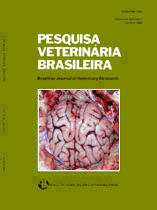 |
|
|
|
Year 2012 - Volume 32, Number 4
|

|
Different pathways in the larval development of the crab Ucides cordatus (Decapoda, Ocypodidae) and their relation with high mortality rates by the end of massive larvicultures, 32(4):284-288
|
ABSTRACT.- Silva U.A.T., Cottens K., Ventura R., Boeger W.A. & Ostrensky A. 2012. Different pathways in the larval development of the crab Ucides cordatus (Decapoda, Ocypodidae) and their relation with high mortality rates by the end of massive larvicultures. Pesquisa Veterinária Brasileira 32(4):284-288. Grupo Integrado de Aquicultura e Estudos Ambientais, Universidade Federal do Paraná, Rua dos Funcionários 1540, Curitiba, PR 80035-050, Brazil. E-mail: ubiratansilva@gmail.com
One of the most limiting factors affecting the larval rearing of Ucides cordatus in the laboratory is a period of high mortality, which usually occurs late in the course of the larviculture during the metamorphosis from the zoeal to the megalopal phase. The objective of the present research was to analyze the post-embryonic development of U. cordatus on an individual basis and, in particular, to search for patterns linking disturbances in the molting process to the high larval death rates observed in massive larvicultures. A total of 50 larvae were individually reared from hatching to metamorphosis into the megalopal phase under controlled conditions, fed a combination of microalgae and rotifers. The survivorship rate was 70% until zoea V. The 35 surviving zoea V larvae followed two different pathways. Eleven underwent metamorphosis directly to megalopa, eighteen molted to zoea VI and six died as zoea V. In the last molting event, only two zoea VI larvae reached the megalopal stage, while the remaining sixteen died. In further observation under microscope, 13 of the dead zoea VI showed characteristics of the pre-molt stage and pereiopods disproportionably large in relation to the carapace. The observed pattern resembles the Molt Death Syndrome (MDS) described for other decapod species, in which larvae die in the late pre-molt phase of the molting cycle. We suggest that U. cordatus larvae develop disturbances in the molting process similar to the MDS described for other species and that these disturbances are related to a more complex pathway involving the emergence of larval stage zoea VI. |
| |
|
|
| |
|
 |